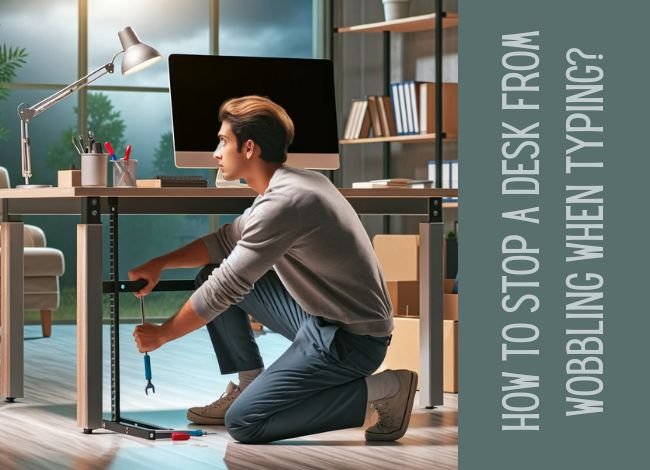
Typing on a wobbly desk can be frustrating and can potentially cause discomfort or strain on your wrists and hands. A wobbly desk can be a nuisance and can be caused by a number of factors. Here are a few potential causes:
- Desk is not level
- The desk is not anchored to the wall
- Desk is not sturdy
- The desk is too large
- Damaged desk legs
Make a desk stable when typing
There are a few things you can try to stop a desk from wobbling:

- Use a carpenter’s level or a smartphone app to check if the desk is level. If it is not, try adjusting the legs or adding shims to level it out.
- If the desk is tall and not anchored to the wall, it may be more prone to wobbling. Try anchoring the desk to the wall using furniture straps or L-brackets.
- If the desk is made of cheap or flimsy materials, it may be more prone to wobbling. Consider adding weight to the desk or using a desk stabilizer to help keep it stable.
- If the desk is too large for the space, it may be more prone to wobbling. Consider downsizing to a smaller desk or finding a way to stabilize it.
- If the legs of the desk are damaged or wobbly, it may cause the entire desk to wobble. Try tightening any loose screws or replacing any damaged legs to stabilize the desk.
How to Repair the Shaking Legs of a Desk?
Here are a few steps you can try to fix shaking legs on a desk:

- Tighten any loose screws: Check the screws that attach the legs to the desk and make sure they are tightened securely. Use a screwdriver to tighten any loose screws.
- Check for damage: Inspect the legs for any signs of damage, such as cracks or breaks. If any of the legs are damaged, they may need to be replaced.
- Add shims: If the legs are not level, you can try adding shims between the leg and the floor to level the desk. You can use thin pieces of wood or cardboard as shims.
- Use furniture glides: Furniture glides are small rubber pads that can be placed under the legs of the desk to help stabilize it and reduce shaking.
- Consider replacing the legs: If the legs are damaged or beyond repair, you may need to replace them. You can purchase replacement legs online or at a hardware store.
What desk is good for typing?
When it comes to selecting a desk for typing, there are a few key factors to consider:
- Size: The desk should be large enough to accommodate your keyboard, mouse, and monitor but not so large that it takes up too much space.
- Height: The desk should be at a comfortable height for typing. This will typically be around elbow height when seated but can vary based on your individual needs.
- Stability: The desk should be sturdy and not wobble when typing.
- Surface: The desk should have a smooth, flat surface that is comfortable to type on.
- Ergonomics: Consider an ergonomic desk that allows you to adjust the height and angle of the work surface to reduce strain on your wrists and hands while typing.
There are many different desks available that can meet these criteria, including standing desks, sit-stand desks, and traditional desks. Ultimately, the best desk for typing will depend on your individual needs and preferences.

